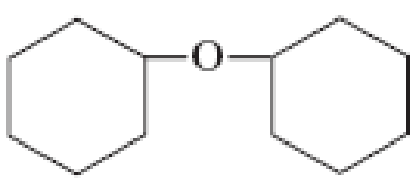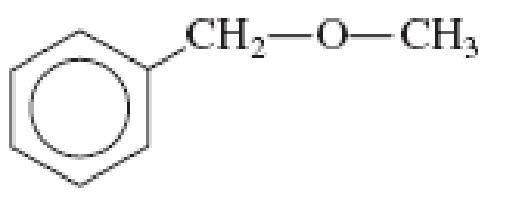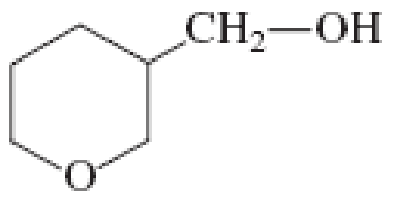
EBK GENERAL, ORGANIC, AND BIOLOGICAL CH
7th Edition
ISBN: 9780100853188
Author: STOKER
Publisher: YUZU
expand_more
expand_more
format_list_bulleted
Textbook Question
Chapter 14, Problem 14.128EP
Classify each of the following molecular structures as that of a cyclic ether, a noncyclic ether, or a nonether.




Expert Solution & Answer
Trending nowThis is a popular solution!

Students have asked these similar questions
Answer this as a dental assistant student
buatkan judul skripsi tentang parasitologi yang sedang trendinh
Dental assistant
Chapter 14 Solutions
EBK GENERAL, ORGANIC, AND BIOLOGICAL CH
Ch. 14.1 - Prob. 1QQCh. 14.1 - Prob. 2QQCh. 14.2 - Prob. 1QQCh. 14.2 - Prob. 2QQCh. 14.2 - Prob. 3QQCh. 14.3 - Prob. 1QQCh. 14.3 - Prob. 2QQCh. 14.3 - Prob. 3QQCh. 14.3 - Prob. 4QQCh. 14.4 - Prob. 1QQ
Ch. 14.4 - Prob. 2QQCh. 14.4 - Prob. 3QQCh. 14.5 - Prob. 1QQCh. 14.5 - Prob. 2QQCh. 14.5 - Prob. 3QQCh. 14.5 - Prob. 4QQCh. 14.6 - Prob. 1QQCh. 14.6 - Prob. 2QQCh. 14.6 - Prob. 3QQCh. 14.7 - Prob. 1QQCh. 14.7 - Prob. 2QQCh. 14.8 - Prob. 1QQCh. 14.8 - Prob. 2QQCh. 14.9 - Prob. 1QQCh. 14.9 - Prob. 2QQCh. 14.9 - Prob. 3QQCh. 14.9 - Prob. 4QQCh. 14.9 - Prob. 5QQCh. 14.9 - Prob. 6QQCh. 14.10 - Prob. 1QQCh. 14.10 - Prob. 2QQCh. 14.11 - Prob. 1QQCh. 14.11 - Prob. 2QQCh. 14.11 - Prob. 3QQCh. 14.12 - Prob. 1QQCh. 14.12 - Prob. 2QQCh. 14.13 - Prob. 1QQCh. 14.13 - Prob. 2QQCh. 14.13 - Prob. 3QQCh. 14.14 - Prob. 1QQCh. 14.14 - Prob. 2QQCh. 14.14 - Prob. 3QQCh. 14.15 - Prob. 1QQCh. 14.15 - Prob. 2QQCh. 14.15 - Prob. 3QQCh. 14.15 - Prob. 4QQCh. 14.16 - Prob. 1QQCh. 14.16 - Prob. 2QQCh. 14.17 - Prob. 1QQCh. 14.17 - Prob. 2QQCh. 14.17 - Prob. 3QQCh. 14.18 - Prob. 1QQCh. 14.18 - Prob. 2QQCh. 14.18 - Prob. 3QQCh. 14.19 - Prob. 1QQCh. 14.19 - Prob. 2QQCh. 14.20 - Prob. 1QQCh. 14.20 - Prob. 2QQCh. 14.20 - Prob. 3QQCh. 14.20 - Prob. 4QQCh. 14.20 - Prob. 5QQCh. 14.21 - Prob. 1QQCh. 14.21 - Prob. 2QQCh. 14.21 - Prob. 3QQCh. 14.21 - Prob. 4QQCh. 14.21 - Prob. 5QQCh. 14 - Prob. 14.1EPCh. 14 - Prob. 14.2EPCh. 14 - Prob. 14.3EPCh. 14 - Prob. 14.4EPCh. 14 - Prob. 14.5EPCh. 14 - Prob. 14.6EPCh. 14 - Prob. 14.7EPCh. 14 - Prob. 14.8EPCh. 14 - Prob. 14.9EPCh. 14 - Prob. 14.10EPCh. 14 - Write a condensed structural formula for each of...Ch. 14 - Write a condensed structural formula for each of...Ch. 14 - Prob. 14.13EPCh. 14 - Prob. 14.14EPCh. 14 - Prob. 14.15EPCh. 14 - Prob. 14.16EPCh. 14 - Prob. 14.17EPCh. 14 - Prob. 14.18EPCh. 14 - Each of the following alcohols is named...Ch. 14 - Prob. 14.20EPCh. 14 - Prob. 14.21EPCh. 14 - Prob. 14.22EPCh. 14 - Prob. 14.23EPCh. 14 - Prob. 14.24EPCh. 14 - Prob. 14.25EPCh. 14 - Prob. 14.26EPCh. 14 - Prob. 14.27EPCh. 14 - Prob. 14.28EPCh. 14 - Prob. 14.29EPCh. 14 - Prob. 14.30EPCh. 14 - Prob. 14.31EPCh. 14 - Prob. 14.32EPCh. 14 - Prob. 14.33EPCh. 14 - Prob. 14.34EPCh. 14 - Explain why the boiling points of alcohols are...Ch. 14 - Explain why the water solubilities of alcohols are...Ch. 14 - Prob. 14.37EPCh. 14 - Prob. 14.38EPCh. 14 - Prob. 14.39EPCh. 14 - Which member of each of the following pairs of...Ch. 14 - Determine the maximum number of hydrogen bonds...Ch. 14 - Determine the maximum number of hydrogen bonds...Ch. 14 - Prob. 14.43EPCh. 14 - Prob. 14.44EPCh. 14 - Prob. 14.45EPCh. 14 - Prob. 14.46EPCh. 14 - Classify each of the following alcohols as a...Ch. 14 - Classify each of the following alcohols as a...Ch. 14 - Classify each of the following alcohols as a...Ch. 14 - Classify each of the following alcohols as a...Ch. 14 - Prob. 14.51EPCh. 14 - Prob. 14.52EPCh. 14 - Prob. 14.53EPCh. 14 - Prob. 14.54EPCh. 14 - Prob. 14.55EPCh. 14 - Prob. 14.56EPCh. 14 - Prob. 14.57EPCh. 14 - Prob. 14.58EPCh. 14 - Prob. 14.59EPCh. 14 - Prob. 14.60EPCh. 14 - The alcohol 2,2-dimethyl-1-butanol cannot be...Ch. 14 - Prob. 14.62EPCh. 14 - Prob. 14.63EPCh. 14 - Prob. 14.64EPCh. 14 - Draw the structure of the aldehyde or ketone...Ch. 14 - Draw the structure of the aldehyde or ketone...Ch. 14 - Prob. 14.67EPCh. 14 - Prob. 14.68EPCh. 14 - Prob. 14.69EPCh. 14 - Prob. 14.70EPCh. 14 - Three isomeric pentanols with unbranched carbon...Ch. 14 - Prob. 14.72EPCh. 14 - Prob. 14.73EPCh. 14 - Prob. 14.74EPCh. 14 - Prob. 14.75EPCh. 14 - Prob. 14.76EPCh. 14 - Prob. 14.77EPCh. 14 - Prob. 14.78EPCh. 14 - Prob. 14.79EPCh. 14 - Prob. 14.80EPCh. 14 - Prob. 14.81EPCh. 14 - Prob. 14.82EPCh. 14 - Prob. 14.83EPCh. 14 - Prob. 14.84EPCh. 14 - Prob. 14.85EPCh. 14 - Prob. 14.86EPCh. 14 - Prob. 14.87EPCh. 14 - Prob. 14.88EPCh. 14 - Prob. 14.89EPCh. 14 - Prob. 14.90EPCh. 14 - Prob. 14.91EPCh. 14 - Classify each of the following compounds as an...Ch. 14 - Draw or write the following for the simplest ether...Ch. 14 - Draw or write the following for the simplest ether...Ch. 14 - Prob. 14.95EPCh. 14 - Prob. 14.96EPCh. 14 - Prob. 14.97EPCh. 14 - Prob. 14.98EPCh. 14 - Prob. 14.99EPCh. 14 - Prob. 14.100EPCh. 14 - Prob. 14.101EPCh. 14 - Prob. 14.102EPCh. 14 - Prob. 14.103EPCh. 14 - Prob. 14.104EPCh. 14 - Prob. 14.105EPCh. 14 - Prob. 14.106EPCh. 14 - Prob. 14.107EPCh. 14 - Prob. 14.108EPCh. 14 - Prob. 14.109EPCh. 14 - Prob. 14.110EPCh. 14 - Prob. 14.111EPCh. 14 - Prob. 14.112EPCh. 14 - Prob. 14.113EPCh. 14 - Give common names for all ethers that are...Ch. 14 - How many isomeric ethers exist when the R groups...Ch. 14 - Prob. 14.116EPCh. 14 - Prob. 14.117EPCh. 14 - Draw condensed structural formulas for the...Ch. 14 - Prob. 14.119EPCh. 14 - Prob. 14.120EPCh. 14 - Prob. 14.121EPCh. 14 - Prob. 14.122EPCh. 14 - Prob. 14.123EPCh. 14 - How do the chemical reactivities of ethers compare...Ch. 14 - Explain why ether molecules cannot hydrogen-bond...Ch. 14 - How many hydrogen bonds can form between a single...Ch. 14 - Classify each of the following molecular...Ch. 14 - Classify each of the following molecular...Ch. 14 - Prob. 14.129EPCh. 14 - Prob. 14.130EPCh. 14 - Prob. 14.131EPCh. 14 - Draw a condensed structural formula for each of...Ch. 14 - Prob. 14.133EPCh. 14 - Prob. 14.134EPCh. 14 - Prob. 14.135EPCh. 14 - Prob. 14.136EPCh. 14 - Prob. 14.137EPCh. 14 - For each of the following pairs of compounds,...Ch. 14 - Assign an IUPAC name to each of the following...Ch. 14 - Prob. 14.140EPCh. 14 - Prob. 14.141EPCh. 14 - Prob. 14.142EPCh. 14 - Prob. 14.143EPCh. 14 - Prob. 14.144EPCh. 14 - Prob. 14.145EPCh. 14 - Prob. 14.146EP
Knowledge Booster
Learn more about
Need a deep-dive on the concept behind this application? Look no further. Learn more about this topic, biology and related others by exploring similar questions and additional content below.Similar questions
- O Macmillan Learning Glu-His-Trp-Ser-Gly-Leu-Arg-Pro-Gly The pKa values for the peptide's side chains, terminal amino groups, and carboxyl groups are provided in the table. Amino acid Amino pKa Carboxyl pKa Side-chain pKa glutamate 9.60 2.34 histidine 9.17 1.82 4.25 6.00 tryptophan 9.39 2.38 serine 9.15 2.21 glycine 9.60 2.34 leucine 9.60 2.36 arginine 9.04 2.17 12.48 proline 10.96 1.99 Calculate the net charge of the molecule at pH 3. net charge at pH 3: Calculate the net charge of the molecule at pH 8. net charge at pH 8: Calculate the net charge of the molecule at pH 11. net charge at pH 11: Estimate the isoelectric point (pl) for this peptide. pl:arrow_forwardBiology Questionarrow_forwardThis entire structure (Pinus pollen cone) using lifecycle terminology is called what?arrow_forward
- This entire structure using lifecycle terminology is called what? megastrobilus microstrobilus megasporophyll microsporophyll microsporangium megasporangium none of thesearrow_forwardHow much protein should Sarah add to her diet if she gets pregnant? Sarah's protein requirements during pregnancy would be higher. See Hint B2. During calculations, use numbers rounded to the first decimal place. In your answer, round the number of grams to the nearest whole number. _______ g ?arrow_forwardC MasteringHealth MasteringNu X session.healthandnutrition-mastering.pearson.com/myct/itemView?assignment ProblemID=17396422&attemptNo=1&offset=prevarrow_forwardMost people, even those who exercise regularly at low to average intensity (1 hour at the gym or a 2- to 3-mile walk several times per week), do not need an increased protein intake. What would be the protein needs of a man named Josh who exercises moderately and is the same age and size as Wayne? Josh is 5 ft, 8 in tall and weighs 183 lb. Round the number of grams to the nearest whole number. During calculations, use numbers rounded to the first decimal place. Because protein requirement is a range, please enter two numbers: lower and upper range values, respectively. Separate the lower and upper range values, in that order, by a comma. ___, ___ g ?arrow_forwardC MasteringHealth MasteringNu X session.healthandnutrition-mastering.pearson.com/myct/itemView?assignment ProblemID=17396422&attemptNo=1&offset=prevarrow_forwardIf left untreated, most HIV-infected individuals will develop AIDS. Current treatments are focused on highlyactive antiretroviral therapy (HAART). HAART usually consists of an orally delivered drug cocktail containingtwo different reverse transcriptase inhibitors and one other drug, such as a protease inhibitor. Question: Develop a pharmacokinetic model of HAART treatment. Consider all 3 drugs. Make sure to include adiagram that illustrates your thinking, state all assumptions, and define your variables. Whatparameters would you need to know to find the concentration of drug in the plasma? In the T cells?(You do not need to write out or solve any equations.)arrow_forwardnot use ai pleseaarrow_forward(A) 25 20 20 15 NPP (Mg C/ha/yr) 10 10 5 0 0 2,000 4,000 6,000 ECOLOGY 4e, Figure 20.11 (Part 1) 2017 Sinauer Associates, Inc. Average annual precipitation (mm) 8,000arrow_forwardexplain the cascade of events (starting with relaxing trade winds) that occurs during El Niño in the eastern Pacific (off the coasts of California/North America and Peru/South America) and which lead to food-chain collapse - start with changes in the physical/oceanographic conditions, andthen systematically describe the cascading effects at each level of the food chain -arrow_forwardarrow_back_iosSEE MORE QUESTIONSarrow_forward_iosRecommended textbooks for you
 Biology (MindTap Course List)BiologyISBN:9781337392938Author:Eldra Solomon, Charles Martin, Diana W. Martin, Linda R. BergPublisher:Cengage Learning
Biology (MindTap Course List)BiologyISBN:9781337392938Author:Eldra Solomon, Charles Martin, Diana W. Martin, Linda R. BergPublisher:Cengage Learning Anatomy & PhysiologyBiologyISBN:9781938168130Author:Kelly A. Young, James A. Wise, Peter DeSaix, Dean H. Kruse, Brandon Poe, Eddie Johnson, Jody E. Johnson, Oksana Korol, J. Gordon Betts, Mark WomblePublisher:OpenStax College
Anatomy & PhysiologyBiologyISBN:9781938168130Author:Kelly A. Young, James A. Wise, Peter DeSaix, Dean H. Kruse, Brandon Poe, Eddie Johnson, Jody E. Johnson, Oksana Korol, J. Gordon Betts, Mark WomblePublisher:OpenStax College
 Biology (MindTap Course List)BiologyISBN:9781337392938Author:Eldra Solomon, Charles Martin, Diana W. Martin, Linda R. BergPublisher:Cengage Learning
Biology (MindTap Course List)BiologyISBN:9781337392938Author:Eldra Solomon, Charles Martin, Diana W. Martin, Linda R. BergPublisher:Cengage Learning Anatomy & PhysiologyBiologyISBN:9781938168130Author:Kelly A. Young, James A. Wise, Peter DeSaix, Dean H. Kruse, Brandon Poe, Eddie Johnson, Jody E. Johnson, Oksana Korol, J. Gordon Betts, Mark WomblePublisher:OpenStax College
Anatomy & PhysiologyBiologyISBN:9781938168130Author:Kelly A. Young, James A. Wise, Peter DeSaix, Dean H. Kruse, Brandon Poe, Eddie Johnson, Jody E. Johnson, Oksana Korol, J. Gordon Betts, Mark WomblePublisher:OpenStax College
07 Physical Properties of Organic Compounds; Author: Mindset;https://www.youtube.com/watch?v=UjlSgwq4w6U;License: Standard YouTube License, CC-BY
